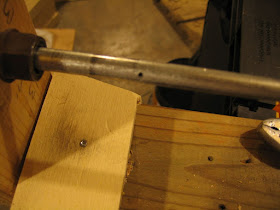Night out on the town? Chainmail.
Dinner with friends? Chainmail.
Swordsman bent on slashing you? Chainmail.
 |
| A chainmail hauberk. |
I decided to try making chainmail. I heard it was a long and arduous process. It is. It took me months. I watched television as I worked, so it wasn't completely unbearable, but I went through eight or nine seasons of different television series.
Start with 17 gauge electric fence wire. If you are attempting a hauberk, get 1/4 mile worth, at least. I'm not sure how much I used. I knew someone that had a spool to spare, so I lucked out.
 |
| The jig, steel dowel, drill, and a couple of coils. |
Next, you need to build a jig. Get a 3/8" diameter 36" long steel dowel from your local home improvement store. Take a file and create a v-groove in one end. Take a 1/16" drill bit and drill a hole. The v-groove allows you to steady the drill as you make the hole. Otherwise your drill bit will slide off the round dowel. This hole will snag your wire and allow you to create coils.
 |
| This is the 1/16" hole. The groove is on the other side- a simple v-groove cut into the dowel with a file. |
I built a jig out of 2x4's. I spaced the verticals at 30", and braced them with scrap. Drill a 3/8" hole in each vertical stand piece. You want these holes to line up as the steel dowel will pass through these holes. I used a GM lug nut as a spacer at the 1/16" hole side since my wire was tearing the opening in the wood while I was making coils. The lug nut had a tapered back side and fit the dowel perfectly. Any 3/8" nut should work.
Attach an electric drill to the other end of the steel dowel, opposite your 1/16" hole. Insert the end of the electric fence wire into the hole in the steel rod.
Slowly, SLOWLY, start twisting the wire around the dowel using the drill. You want to keep your coils nice and tight so that your chainmail rings will have a uniform appearance. If you don't, you'll end up discarding rings because their shape is incorrect and stretched.
You can always reverse the drill direction if the coil wraps back upon itself. Uncoil it, by pulling the wire, then begin coiling again.
Once you have completed a run of coils, it's time to remove them. Remember, the wire is under a lot of tension. If you cut it as close to the steel dowel as possible you will be unharmed. If you cut it farther, the protruding piece of wire could hit you in the hand/fingers as it uncoils. You do NOT want that.
Wire cutters are best to cut the wire. Leave a space between the dowel and drill end of the jig, so you can remove the dowel and wire.
A pair of pliers can pull the wire out of the 1/16" hole.
Now, slide the coils off the rod. Use wire cutters to clip the rings. I hope you have ergonomic wire cutters, if not get a nice pair of leather gloves. This will be tiring, but your arm will eventually get used to it, and the calluses will fade.
My chainmail hauberk used around 15,000 rings. If I hadn't run out of rings, I would have made the entire thing longer, as well as the sleeves longer. I made and cut each one of the rings. In the future I'll probably just buy a chainmail hauberk.
 |
| Partial chainmail, pliers, and groups of five rings. |
You want the chainmail direction to run horizontally around the torso. Think of it as a sheet, you cut a hole for your head, and the rest is flat. I constructed my hauberk similar to that. then I attached the front and back at my ribcage, and closed the sleeves. I tapered the sleeves larger as I went up my arm. Closing the armpits was a tricky, but once I figured out the first one, the second went much quicker.
 |
| This ring pattern is running right to left or horizontal. |
I bend the coils with pliers to close the loop. Run one of the loops through four others. Joining groups of five is quicker than joining one at a time. Be sure that when you add a group of five, the patterns maintain their direction. You want to bend the end of the rings side to side, rather than apart so that they maintain the round shape.
 |
| The one ring is inserted into four others to create a group of five. |
Making a coif would be very similar. The weaving of the rings would be the same.
Now, I'm the talk of the town when I frequent my favorite fast food establishments. People admire and point, laughing at the sheer amount of work that went into such a thing.
If you have any questions, leave a comment. I'm happy to help. Thanks!

No comments:
Post a Comment